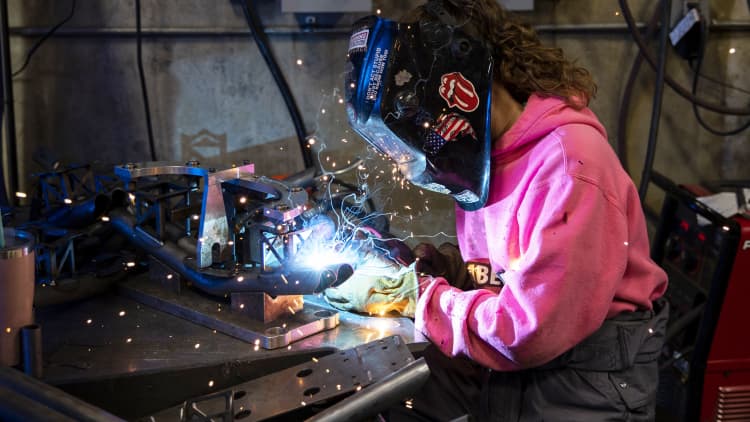
Hiring was a huge letdown in April, with nonfarm payrolls increasing by a much less than expected 266,000 and the unemployment rate rose to 6.1% amid an escalating shortage of available workers.
Dow Jones estimates had been for 1 million new jobs and an unemployment rate of 5.8%.
Many economists had been expecting an even higher jobs number amid signs that the U.S. economy was roaring back to life.
There was more bad news: March's originally estimated total of 916,000 was revised down to 770,000, though February saw an upward revision to 536,000 from 468,000.
However, markets had only a mild reaction to the bad news, a sign that investors expect the Federal Reserve to keep its ultra-easy policies in place and believe that the big miss likely was a short-term phenomenon.
"It certainly takes the pressure off the Fed and takes an imminent rate increase off the table," said JJ Kinahan, chief market strategist at TD Ameritrade. "We're not going to see inflation in wages, and we don't have as many people employed as we thought, so we have to keep the party going."
While average hourly earnings actually jumped from the March level, they were little changed year over year as more low-wage earners return to their jobs.
"I think this is just as much about a shortage in labor supply as it is about a shortage of labor demand," said Jason Furman, an economist at Harvard University and a former Obama administration advisor. "If you look at April, it appears that there were about 1.1 unemployed workers for every job opening. So there are a lot of jobs out there, there is just still not a lot of labor supply."
The battered leisure and hospitality industry saw the biggest hiring gains, adding 331,000 workers though that still left the industry nearly 2.9 million shy of where it was before the pandemic.
However, the lack of available workers is a "crisis," said Carlos Gazitua, president and CEO of Sergio's Restaurants in Southern California.
"We've increased wages. We have about three different staffing agencies that are constantly looking for people," Gazitua said. "Other restaurateurs are walking around neighborhoods passing out flyers. The heroes in our communities are the people currently working for you and me. These people are burnt out."
The "other services" industry was next in hiring with 44,000, due largely to gains in repair and maintenance as well as personal and laundry services.
Local government education added 31,000 jobs as children returned to in-school learning, while social assistance increased by 23,000. Financial activities increased by 19,000.
Professional and business services saw a steep 111,000 decline in jobs in temporary help, while support services lost 15,000 positions. Courier help declined by 77,000 and manufacturing lost 18,000 positions.
Total employment in the household survey rose by 328,000, still leaving the level more than 7.5 million below where it was in February 2020. The labor force participation rate rose 0.2 point to 61.7%, its best level since August, while the employment-to-population level increased to 57.9%, its best since March 2020 but still below the 61.1% in February 2020.
An alternative measure of unemployment that includes discouraged workers and those holding part-time jobs for economic reasons fell to 10.4%, down 0.3 point from March for its lowest level since March 2020. That "real" unemployment rate had peaked at 22.9% in April 2020 as the headline jobless rate hit 14.8%.
The report comes amid robust growth that saw gross domestic product rise at a 6.4% annualized pace in the first quarter, and as many economists see a burst of 10% or more in the second quarter.
Businesses have stepped up the hiring pace as Covid-related restrictions have been relaxed amid widespread vaccine distribution and declining cases and hospitalizations. There are signs that the pace of hiring is likely to continue into the summer, as new jobless claims last week fell below 500,000 for the first time since the early days of the pandemic.
Federal Reserve officials have been expressing confidence in the recovery's pace recently but have stressed more challenges are ahead. The central bank is committed to returning to full employment that is inclusive across racial, gender and income classes, and has pledged to keep its ultra-easy policies in place even amid the rapid growth.
The Fed has stressed that even with the large employment gains, millions of Americans who were employed before the pandemic have yet to return to work.
At the same time, the Biden administration wants Congress to allocate some $4 trillion more in spending across a broad swath of areas it considers infrastructure.
While that has been happening, multiple economic indicators have shown sharp rebounds in stimulus-driven retail spending, manufacturing and continued strength in the housing market.
That activity has come as the U.S. vaccinates more than 2 million people a day, a pace that has tailed off recently but still remains strong.
Become a smarter investor with CNBC Pro.
Get stock picks, analyst calls, exclusive interviews and access to CNBC TV.
Sign up to start a free trial today.


